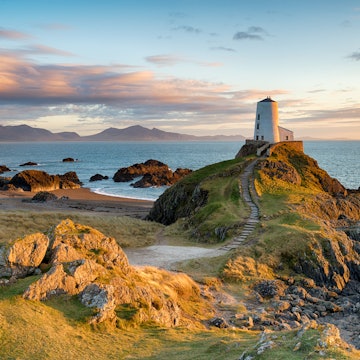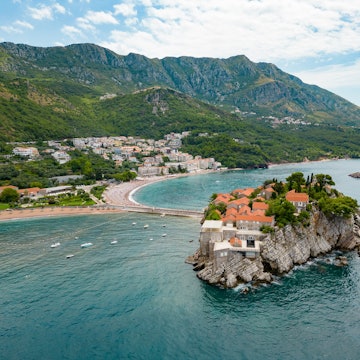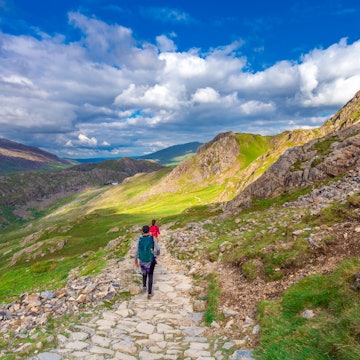

Not all outdoor adventures demand adrenaline, try a tranquil canoe on the River Wye. Billy Stock/Shutterstock
Wales is an outdoor enthusiast’s dream, and tumbling hills, craggy peaks, vast beaches, meandering rivers and decent waves can be found in almost every county.
The Wales Coast Path encircles the entire country, providing coastal exploration opportunities for all abilities. There are also three national parks, five Areas of Outstanding Natural Beauty (AONBs) and over 1000 designated Special Sites of Scientific Interest (SSSIs), including ancient woodlands, sand dunes and wetlands.
Whether you’re into pushing your limits or just looking for a break from the daily grind, Wales is an ideal destination. With its varied landscapes let you connect with nature, while its countless small villages with cozy pubs and old-world hospitality let you really slow down.
1. There are plentiful hiking options in Wales
To walk or hike in Wales is to journey through the country’s history: cliffs carved by the sea, valleys burrowed out then transformed into wildlife havens, man-made paths along sky-kissing hills... The country’s landscapes capture its rich past.
The two big hitters for walkers are among the highest and best-known Welsh peaks. Eryri National Park (Snowdonia) is home to Yr Wyddfa (previously referred to as Mt Snowdon), Wales' highest mountain. There are multiple routes here giving walkers options to match their abilities and preferences.
Pen-y-Fan in Parc Cenedlaethol Bannau Brycheiniog (Brecon Beacons National Park) is the highest peak in South Wales, accessed by a relatively straightforward ascent and with rewarding panoramic summit views. Both peaks are popular, so you’ll have to queue if you want a summit selfie in summer.
Away from the popular peaks, there are thousands of walks to choose from and many opportunities to see Wales’ natural beauty. Good places to start for inspiration include the Wales Coast Path, Offa’s Dyke Path and similar long-distance routes that can be broken into smaller sections.

2. Families can go sheep trekking
This only-in-Wales kind of outdoors experience (along with...bog snorkeling) is family-friendly and a special way to connect with the long history of Wales as a farming nation. Get ready to walk (and cuddle) one of Wales’ many woolly inhabitants in scenic Brecon countryside with Jacob Sheep Trekking. You’ll walk through beautiful Welsh countryside with one of a range of sheep breeds, and learn all about the animals as you go.
In spring, you might even get involved in the lambing season. You’ll find out how farmers tend to their flock – and if you're lucky, you may get to bottle-feed the lambs. And for anyone who’s a bit crafty, a felting workshop uses wool from the very sheep you’ve just gotten to know.

3. Discover the thrill of coasteering
It might feel a bit like auditioning for It’s a Knockout (if you haven’t seen the TV show, look it up). Donning wetsuits, helmets and lifejackets, participants climb rocks before leaping into the sea, then swimming in hidden coves and sea caves along Pembrokeshire’s rugged coastline. There’s a fair bit of scrambling and occasional jumping off rocky ledges into the ocean, as waves roll up and down on the tides. Keep your eyes peeled to spot the marine wildlife, seals and seabirds like guillemots, gannets and Manx shearwaters that inhabit this coast.
Coasteering originated in Pembrokeshire and now anyone with a decent level of fitness and a healthy appetite for risk-taking can get out and have an adrenaline-packed adventure (under the guidance of a trained instructor, of course).
4. Have adrenaline-fueled fun in a former slate quarry
Across much of the Welsh countryside, you’ll find remnants of its mining history. And some former quarries have been repurposed as adventure-sports centers. At Zip World Penrhyn Quarry, you’ll hurtle, slide and drift around an obstacle-filled slate quarry in a three-wheeled kart. The karts have no engines: instead, you zoom down a track on the steep gradient, racing your fellow participants. Or try out the zip-line and zoom over the quarry at 100 miles (160km) per hour. Another Zipworld favorite for kids, Bounce Below at Blaenau Ffestiniog has trampolines in an underground cave. For a less extreme way to experience life underground in Wales, there’s also the opportunity to descend into a disused mine to see mining heritage in action at Big Pit National Coal Museum.

5. Feel the serenity while stand-up paddleboarding
Once you’ve managed to master the stand-up paddleboard (it’s all about balance!) you can glide on the water, powered by your arms and the tide, or the steady flow of a river. Though it looks strenuous from afar, SUPing (as it’s often called) is a surprisingly serene way to experience nature. You’re higher than in a canoe or kayak, giving you a larger view. The gliding motion of the board over the water can also feel smoother than the effort paddling a canoe. Great places to give it a go in Wales include Barry Island in Whitmore Bay near Cardiff; in the coves of Pembrokeshire; or on the tranquil glacial waters of Llyn Padam in Snowdownia. Always be sure to book a tour with a registered and reputable guide.

6. Go cycling and mountain biking in Wales
Wales offers a range of cycling experiences, from challenging mountain trails to serene coastal paths and scenic valley routes. Whether you opt for one of the National Cycle Network routes, a waymarked woodland trail through a national park or a gentle meander alongside a beach, you'll find somewhere memorable to get the wheels going.
If you’re after routes under 20 miles (32km), there are plenty of official trails to choose from. The relatively flat, 18-mile (29km) Elan Valley Trail follows the route of an old railway line, offering glimpses of vast reservoirs, impressive Victorian dams and aqueducts, rolling hills and thriving woodlands. You might even spot (or hear) red kites overhead. After night falls, Elan Valley is a Dark Sky reserve.
The Rheidol Cycleway from Aberystwyth to Devil’s Bridge combines on-road and off-road sections into a fun, nature-cushioned route. Lush valleys and dense forests precede the steep climb to the stacked bridges and dramatic Mynach Falls.
Just south of Bannau Brycheiniog (Brecon Beacons) near Merthyr Tydfil, the UK's first full-scale bike park, BikePark Wales, has over 40 MTB trails from beginners to expert.
7. See another side of Wales by boat
With an 870-mile (1400km) coastline and hundreds of rivers and lakes, there are a host of ways to explore Wales on the water. If you want to get offshore, you can book a puffin-spotting trip to Skomer Island. Near Anglesey in the north, take a RIB ride on the Menai Strait, From Cardigan Bay, take the family on a dolphin-watching tour.
For a more challenging and adrenaline-pumping water-based adventure, Wales is a hub for white-water rafting and white-water kayaking. (Find out more at Canolfan Tryweryn, Wales’ white-water rafting center.) If you’d like to tackle a river at a more sedate pace, look into half-day or day-long canoeing and kayaking trips, available all over the country. It’s also possible to book a multi-day canoeing tour on the River Wye. If you want to go it alone, but need to pick up gear, look for Visit Wales–approved kit-rental companies, or go with a certified activity provider.
8. Canoe across Britain's highest aqueduct at Llangollen
Paddling across Llangollen's "stream in the sky", is the canoe trip of your dreams, so long as you don't look down. Hop in a canoe or kayak and bravely cross the Pontcysyllte Aqueduct – an 18-arched marvel that carries the Llangollen Canal over the River Dee. Built between 1795 and 1805 by the astounding minds of Thomas Telford and William Jessop, this aqueduct is the longest and highest in Britain, stretching 307m and towering 38m above the river. The aqueduct and canal's designation as a UNESCO World Heritage site in 2009 cemented its status as a Welsh cultural treasure.
Learn paddling basics on the canal before you head in a formation towards the 3.7m-wide aqueduct. On arrival, you may have to queue behind traditional canal boats before you get to glide across the sky; nothing but a slender ledge separates you from the dizzying drop to the lush Dee Valley beneath you. Given the narrowness of the aqueduct and the sheer drop below, the view is both exhilarating and nerve-wracking.

9. Try surfing on the Atlantic coast
With its miles of Atlantic-facing coastline, Wales offers surfers consistent swells and largely uncrowded beaches (outside the summer peak). And along its varied coast, you’ll find surf spots that cater to different skill levels. Many of the best beaches for surfing are around Pembrokeshire and the Gower Peninsula – and you can count on local intel from surfers to get you to the best breaks and secret spots.
For first-time surfers in Wales, Rhossili Bay on the Gower Peninsula has good waves and is often ranked one the best beaches in the UK. For absolute beginners, Whitesands in Pembrokeshire is a good bet, with several local surf schools. Broadhaven is also a popular spot, though not one recommended for beginners as the waves are powerful despite the gorgeous sandy beach. Also in Pembrokeshire, you can head to the more remote Freshwaster West or Manorbier near the characterful seaside town of Tenby. Further north, Hell’s Mouth (Porth Neigwl) on the Llŷn Peninsula offers long beach breaks, best in winter, that are ideal for more-advanced surfers.
This article was adapted from Lonely Planet’s Wales guidebook, published in June 2025.
















